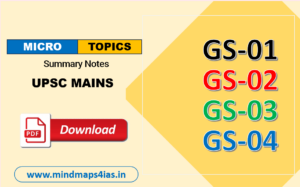Relevance: The India State of Forest Report (ISFR) is crucial for understanding forest cover dynamics in India, which is relevant for the UPSC examination, particularly in topics related to environmental policy, biodiversity, and sustainable development.
Why in the News?
The 18th biennial State of Forest Report (ISFR-2023) was released by Environment Minister Bhupender Yadav on December 21, 2024, at the Forest Research Institute in Dehradun. The report provides comprehensive insights into the status of forest cover in India using satellite data.
Key Takeaways
- Forest Cover Statistics:
- India’s total green cover has surpassed 25%, with 827,357 sq km (25.17%) under forest (21.76%) and tree (3.41%) cover.
- The area classified as dense forests is 410,175 sq km.
- Net Forest Cover Change:
- The net forest cover increased by 156.41 sq km from 2021 to 2023, resulting in a total forest area of 715,342.61 sq km, reflecting a minimal rise of 0.05% compared to the previous assessment.
- Long-term Trends:
- Between 2003 and 2013, forest cover increased by 0.61 percentage points, while from 2013 to 2023, it grew by only 0.53 percentage points.
- Tree Cover Growth:
- Tree cover saw a significant increase from 2.91% in 2021 to 3.41% in 2023, adding 1,285.4 sq km.
- The overall green cover increased by 1,445.81 sq km compared to 2021.
- Loss of Dense Forests:
- The report indicates that 3,913 sq km of dense forests have been lost since 2021.
- Over the past two decades, India has lost a total of 24,651 sq km (over 6.3%) of its dense forests.
- Plantations and Dense Forests:
- Approximately 1,420 sq km of plantations have transitioned into dense forests since 2021, indicating a concerning trend where plantations are replacing natural dense forests.
- Western Ghats Assessment:
- For the first time, an assessment was conducted for the Western Ghats, revealing a loss of 58.22 sq km of forest cover since 2013 in eco-sensitive areas.
- Very dense forests increased by 3,455.12 sq km, but moderately dense and open forests decreased significantly.
- Mangrove Cover Decline:
- Mangrove species have decreased by 7.43 sq km, with Gujarat experiencing a loss of 36 sq km, and Andaman and Nicobar Islands losing about 4.65 sq km.
Performance of States
- Northeastern States Trends:
- The northeastern states collectively recorded a decline in forest cover by 327.30 sq km, with only Mizoram showing an increase of 178 sq km.
- Significant declines were observed in Nagaland, Tripura, Meghalaya, and Assam.
- States with Maximum Increase in Forest Cover:
- Chhattisgarh led with an increase of 683.62 sq km, followed by Uttar Pradesh (559.19 sq km) and Odisha (558.57 sq km).
- Conversely, Madhya Pradesh saw the largest decrease at 612.41 sq km, followed by Karnataka (459.36 sq km) and Ladakh (159.26 sq km).
- Recorded Forest Area (RFA):
- The top three states with the largest forest and tree cover are:
- Madhya Pradesh: 85,724 sq km
- Arunachal Pradesh: 67,083 sq km
- Maharashtra: 65,383 sq km
- The top three states with the largest forest and tree cover are:
Key Terms Defined
- Forest Cover:
- Areas with a tree canopy density of more than or equal to 10% over one hectare or more.
- Dense Forests:
- Areas with a canopy density of 40% or above.
- Open Forests (OF):
- Areas with a canopy density between 10% and 40%.
- Very Dense Forests (VDF):
- Areas with at least 70% canopy density.
- Recorded Forest Area (RFA):
- Geographic areas recorded as ‘forest’ in government records under the Indian Forest Act, including reserved and protected forests.
- Tree Cover:
- Areas covered by trees outside designated forest areas.
The ISFR-2023 highlights both progress and challenges in India’s forest management and conservation efforts. While there has been an increase in overall green cover, significant losses in dense forests and mangroves raise concerns about biodiversity and ecological balance. Understanding these dynamics is essential for UPSC aspirants as they reflect critical issues related to environmental policy and sustainable development in India today.
















